Wetland knives
by Keith Spencer
Australian Shooter February 2002
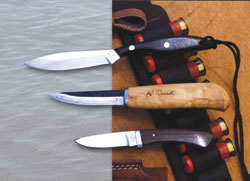
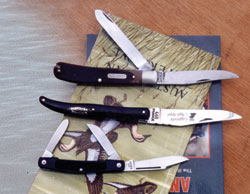
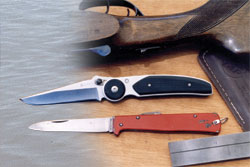
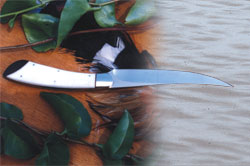
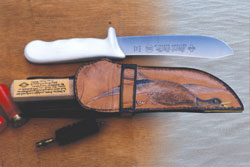
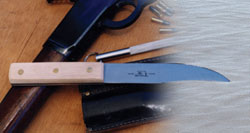 Not too many weeks away in the far north, the flooding wet season will subside, giving way to the dry and the formation of accessible billabongs and waterways teaming with wildlife. To the south,
below the 26th parallel, where there are four seasons, autumn will herald
in the winter months, which attract four-wheel drivers and boat folk into
the wetlands. By late March, early April, hunters and fishers will be
moving in and around rivers, lakes, estuaries and swamps all over the continent.
Not too many weeks away in the far north, the flooding wet season will subside, giving way to the dry and the formation of accessible billabongs and waterways teaming with wildlife. To the south,
below the 26th parallel, where there are four seasons, autumn will herald
in the winter months, which attract four-wheel drivers and boat folk into
the wetlands. By late March, early April, hunters and fishers will be
moving in and around rivers, lakes, estuaries and swamps all over the continent.
In some areas a duck season will be declared and in Victoria, where wetlands are in abundance, duck hunters will gather at popular locations and set up camps in readiness for the season’s opening. Often, it becomes a shooter’s social event, as they sit around camp-fires yarning about this and that after the day’s shoot. They talk about how well they went, about the guns they use and like (but maybe cannot afford to own), about working gundogs and about their favourite knives.
To the uninformed, a knife is a knife, so long has you have one, because you might need to cut or dress something when you are out in the bush. Enlightened outdoors folk know you should carry knives appropriate to the environment you plan to visit and in accordance with the work you expect to do.
To work the wetlands calls for fish, fowl and bunny knives that are small, slim and lightweight. Try not to carry any more than you need to. As it is, shotguns are large to shoulder and 12-gauge cartridges weigh heavy. You also need to carry the game you’ve taken. Fortunately, camouflaged wet-weather gear is light, but if it is cold you will need to wear your winter-woollies.
Don’t go anywhere without a belt order - water canteen, belt knife and dilly bag containing survival stuff. You may well be surrounded by water, but it is wise to purify the water taken from swamps and lakes. Make sure the medical things in your survival kit are up to scratch. You wouldn’t be the first bloke to stumble into some old rusty barbed wire in the undergrowth. Be ready to cope with the unforseen.
Not all creatures are fair game to take. It is important to be able to identify the difference between the species of waterfowl, fish and crustaceans, to know when they can be hunted and fished (acquire licences as required) and to observe any bag limits imposed. Remember that game laws vary between states and territories of Australia, so ask the wildlife authorities about (literally) the rules of the game.
The most hunted waterfowl (when a duck season is declared) are black duck, grey teal, wood duck, chestnut teal and mountain duck. You need a small knife that will gut, fillet and help pluck the bird or, as I saw written in an American book on the subject, a knife for picking, eviscerating and disjointing. Somehow, I don’t feel comfortable telling my mates I’m going to eviscerate something…I think I’ll stay with the word gutting.
Those small, slim knives I referred to can be fixed blades or folders. The long clipped blade style is good. That is, a sabre-like shape with the back of the blade clipped for two-thirds of the length of the blade; not dissimilar to the traditional Spanish clasp knife blade and the French Laguiole folder. In the same vein is the more modern American muskrat folding blade shape. They are excellent for slitting birds to evacuate the guts, breasting them out and completely filleting (although birds are rarely boned out).
Small birds, such as quail, can be gutted using a bird hook (gut hook) that can be inserted in the vent, twisted and withdrawn, bringing the entrails with it. Some pocketknives are available with the hook as one of the folding components. It is preferable to refer to the little tool as a bird hook rather than gut hook, because the term can be confused with gut hook knives that have a sharp, hooked slitting facility factored onto the back of the blade at the tip.
Birds can be dry plucked or wet plucked and singed to remove pinfeathers. In difficult cases, paraffin (wax) can be added to the scalding water. The wax melts and rises to the surface. When the bird is dipped, the wax coats the feathers and hardens, seizing the feathers. Using a blunt knife (keep an old knife especially for the purpose) scrape towards the head and the feathers will come off with the dry wax.
Sometimes it is easier to skin birds than pluck them. Simply slit the breast and, with the aid of a pair of pliers, strip off the skin flayed back by the knife. The Leatherman tool, a pliers-priority pocket tool kit popular among hunters, comes in handy for this job. A slender, small knife is ideal for processing the offal (giblets, heart, liver and gizzard) that has to be slit open to clean and wash.
Wetlands make good hunting grounds. In addition to waterfowl, there are often fish to catch and maybe rabbits breeding in the area, which means there are foxes in the vicinity. And hopefully, if there are feral cats lurking around, you will get the opportunity to eradicate them. Wild cats stake out waterholes and prey on the little creatures that do not perceive feral felines as their natural enemies, thereby making them easy targets on the way to their extinction.
Small and slim-bladed folding and fixed-blade knives are all you need to gut, skin, bone and fillet game and fish of the wetlands.
